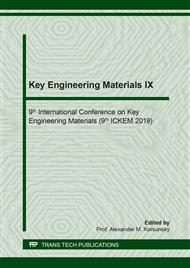[1]
S.A.M. Tofail, E.P. Koumoulos, A. Bandyopadhyay, S. Bose, L. O'Donoghue, C. Charitidis, Additive manufacturing: Scientific and technological challenges, market uptake and opportunities, Mater. Today 21 (2017) 22–37.
DOI: 10.1016/j.mattod.2017.07.001
Google Scholar
[2]
X. Wang, M. Jiang, Z. Zhou, J. Gou, D. Hui, 3D printing of polymer matrix composites: A review and prospective, Compos. Part B Eng. 110 (2017) 442–458.
DOI: 10.1016/j.compositesb.2016.11.034
Google Scholar
[3]
Q. Sun, G.M. Rizvi, C.T. Bellehumeur, P. Gu, Effect of processing conditions on the bonding quality of FDM polymer filaments, Rapid Prototyp. J. 14 (2008) 72–80.
DOI: 10.1108/13552540810862028
Google Scholar
[4]
P. Tran, T.D. Ngo, A. Ghazlan, D. Hui, Bimaterial 3D printing and numerical analysis of bio-inspired composite structures under in-plane and transverse loadings, Compos. Part B Eng. 108 (2017) 210–223.
DOI: 10.1016/j.compositesb.2016.09.083
Google Scholar
[5]
G. Postiglione, G. Natale, G. Griffini, M. Levi, S. Turri, Conductive 3D microstructures by direct 3D printing of polymer/carbon nanotube nanocomposites via liquid deposition modeling, Compos. Part A Appl. Sci. Manuf. 76 (2015) 110–114.
DOI: 10.1016/j.compositesa.2015.05.014
Google Scholar
[6]
Y. Zhuang, W. Song, G. Ning, X. Sun, Z. Sun, G. Xu, B. Zhang, Y. Chen, S. Tao, 3D–printing of materials with anisotropic heat distribution using conductive polylactic acid composites, Mater. Des. 126 (2017) 135–140.
DOI: 10.1016/j.matdes.2017.04.047
Google Scholar
[7]
C.-C. Kuo, L.-C. Liu, W.-F. Teng, H.-Y. Chang, F.-M. Chien, S.-J. Liao, W.-F. Kuo, C.-M. Chen, Preparation of starch/acrylonitrile-butadiene-styrene copolymers (ABS) biomass alloys and their feasible evaluation for 3D printing applications, Compos. Part B Eng. 86 (2016) 36–39.
DOI: 10.1016/j.compositesb.2015.10.005
Google Scholar
[8]
R.B. Dupaix, M.C. Boyce, Finite strain behavior of poly(ethylene terephthalate) (PET) and poly(ethylene terephthalate)-glycol (PETG), Polymer (Guildf). 46 (2005) 4827–4838.
DOI: 10.1016/j.polymer.2005.03.083
Google Scholar
[9]
A. Locker, PETG filament guide 2018 - Explained, compared and reviewed, (2018).
Google Scholar
[10]
M. Domingo-Espin, J.M. Puigoriol-Forcada, A.A. Garcia-Granada, J. Llumà, S. Borros, G. Reyes, Mechanical property characterization and simulation of fused deposition modeling Polycarbonate parts, Mater. Des. 83 (2015) 670–677.
DOI: 10.1016/j.matdes.2015.06.074
Google Scholar
[11]
C. Casavola, A. Cazzato, V. Moramarco, C. Pappalettere, Orthotropic mechanical properties of fused deposition modelling parts described by classical laminate theory, Mater. Des. 90 (2016) 453–458.
DOI: 10.1016/j.matdes.2015.11.009
Google Scholar
[12]
A.K. Sood, R.K. Ohdar, S.S. Mahapatra, Parametric appraisal of mechanical property of fused deposition modelling processed parts, Mater. Des. 31 (2010) 287–295.
DOI: 10.1016/j.matdes.2009.06.016
Google Scholar
[13]
L. Wang, D.J. Gardner, Contribution of printing parameters to the interfacial strength of polylactic acid (PLA) in material extrusion additive manufacturing, Prog. Addit. Manuf. 3 (2018) 165–171.
DOI: 10.1007/s40964-018-0041-7
Google Scholar
[14]
T. Galeta, P. Raos, J. Stojšić, I. Pakši, Influence of Structure on Mechanical Properties of 3D Printed Objects, Procedia Eng. 149 (2016) 100–104.
DOI: 10.1016/j.proeng.2016.06.644
Google Scholar
[15]
F. Ning, W. Cong, Y. Hu, H. Wang, Additive manufacturing of carbon fiber-reinforced plastic composites using fused deposition modeling: Effects of process parameters on tensile properties, J. Compos. Mater. 51 (2017) 451–462.
DOI: 10.1177/0021998316646169
Google Scholar
[16]
International Organization for Standardization, ISO 527-2:2012: Plastics - Determination of tensile properties - Part 2: Test conditions for moulding and extrusion plastics, (2012).
DOI: 10.3403/30216860
Google Scholar
[17]
C.M.O. Müller, J.B. Laurindo, F. Yamashita, Effect of cellulose fibers on the crystallinity and mechanical properties of starch-based films at different relative humidity values, Carbohydr. Polym. 77 (2009) 293–299.
DOI: 10.1016/j.carbpol.2008.12.030
Google Scholar



